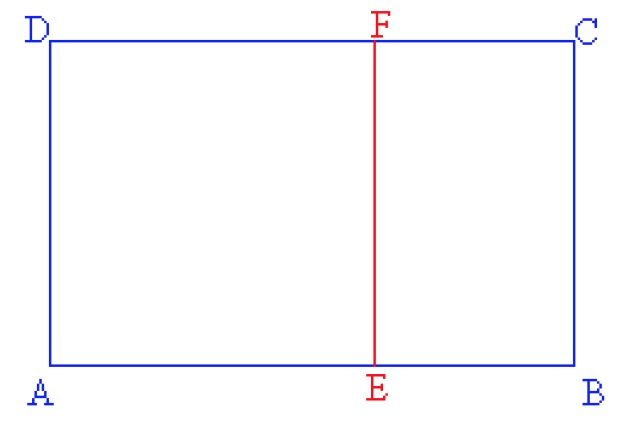4. The golden ratio
The golden ratio
The golden ratio is obtained when a line segment is divided into two parts, [[$ a $]] and [[$ b $]], so that the ratio of the shorter part to the longer part is the same as the ratio of the longer part to the whole segment.
 [[$ \displaystyle\frac {a} {b} = \displaystyle\frac {b} {a + b} $]]
[[$ \displaystyle\frac {a} {b} = \displaystyle\frac {b} {a + b} $]]In general, the inverse of the ratio is used as the numerical value of the golden ratio [[$ \displaystyle\frac {b} {a} = 1,618034… $]] .
If a rectangle is divided into two parts by a line that is parallel to the side of the rectangle, a similar rectangle with the original rectangle is usually not formed. However, a rectangle is said to be a golden rectangle if it can be divided into a square and a smaller rectangle so that the smaller rectangle is similar to the original rectangle.
The rectangles [[$ ABCD $]] and [[$ BCFE $]] are similar if the lengths of their sides are in the golden ratio.
[[$ \displaystyle\frac {AB} {BC} ≈ 1,618034… $]].
Example 1
The end of the Parthenon in Athens is a golden rectangle. The height of the end is [[$ 19 $]] m. How wide is the end?
Solution:
The ratio of the length of the longer side of the golden rectangle to the shorter side is [[$ 1,618034… $]]. Let's signify the width of the temple with [[$ x $]] and solve the equation.
[[$ \quad \begin{align} \frac {x} {19 \text{ m}} &= 1,618034... \space ||·19 \text{ m} \\ \\
x &= 19 \text{ m} · 1,618034... \\ \\
x &\approx 31 \text{ m} \end{align} $]]
Answer: The width of the temple is about 31 m.
Exercises
Basic exercises
Applied exercises
Challenging exercises
3/04. Submission folder for answers
Sinulla ei ole tarvittavia oikeuksia lähettää mitään.
